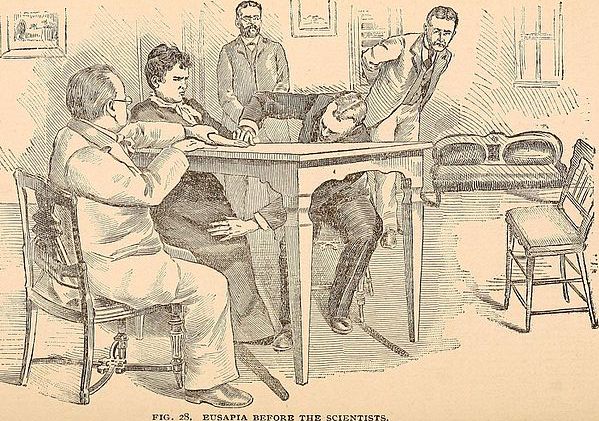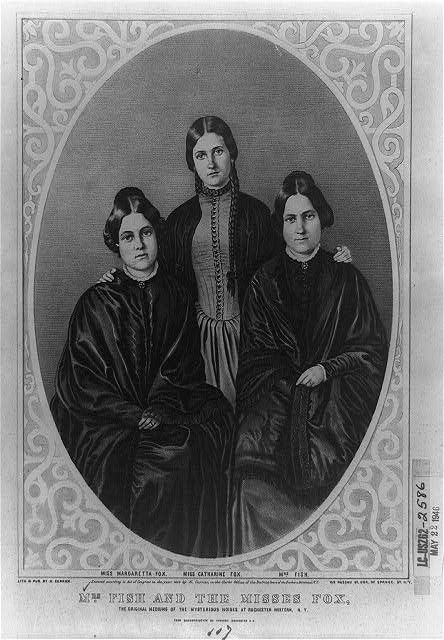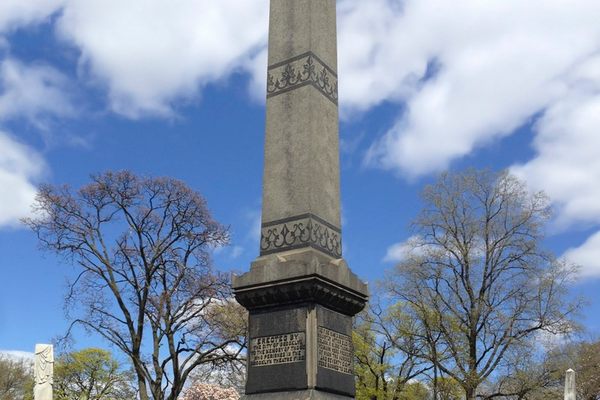The Teen Girls Who Talked to the Dead

Margaret, Kate and Leah Fox. (Photo: Public Domain/WikiCommons)
It was nearing midnight in late March 1848 when two young girls, Katie and Maggie Fox, cried out to their parents from their shared Hydesville, New York bedroom. Mysterious rappings noises were reverberating through the room and keeping the girls awake. The Fox family searched the house by candlelight, but found no source for the noise. The next night, the rappings commenced again. And the night after that–and every night for the next two weeks. The rappings happened for several hours each night, and it left the Fox family frightened, confused and tired.
On March 31st, the girls were sent to bed early, in an attempt to make up for their lost rest. Almost immediately, the rappings began again. This time, Katie responded to the noises by producing her own claps. The rappings, amazingly, responded in kind. Maggie joined in, asking whatever was making the noises to “do this just as I do.” She clapped four times and the knocking happened four times. For several hours, the two girls continued to interact with the source of the sounds. Through this call and response questioning, the girls concluded that this was an “invisible intelligence,” a spirit of a murdered tin peddler named Charles B. Rosna whose remains were still buried underneath the house. When their mother Margaret tried to speak to the spirit, the rappings stopped. Apparently, the spirit would only communicate with Katie and Maggie.

The next night, Margaret invited the neighbors over to watch her daughters communicate with this spirit. The neighbors, at first skeptical, asked a series of increasingly intimate questions about themselves to the supposed ghost. With the help of Katie and Maggie, the spirit answered every question (through “yes or no” rappings) correctly, sometimes embarrassingly so. The guests were shocked, awed, and scared, but some needed further proof. Several volunteers grabbed shovels and dug into the cellar of the Fox house, looking for the body of “Charles Rosna.” Rising water stopped them from digging further, but the inability to uncover proof did not deter the believers. They were convinced that there was a spirit in their small town, and that the teenage Fox sisters were capable of talking with the dead.

An illustration from the 1897 book Hours with the Ghosts, or, Nineteenth Century Witchcraft: Illustrated Investigations into the Phenomena of Spiritualism and Theosophy, showing scientists investigating the claims of a spirit medium. (Image: Public Domain/WikiCommons)
For much of the mid-19th century, the Fox Sisters were rock stars–traveling around the world to communicate with those beyond the veil. By the 1880s, there were over eight million believers in the Fox Sisters’ ability to talk with the departed. Katie and Maggie’s gifts were so highly regarded that they inspired a religious phenomenon, which would become known as spiritualism. Over the years, spiritualism would inspire Arthur Conan Doyle, give hope to President Lincoln’s widow, Mary Todd Lincoln, and anger the great magician Harry Houdini, who was convinced the entire thing was a hoax.
Knowing their gifts would not be properly recognized in the small town of Hydesville, Margaret sent her two daughters to live with their elder sister, Leah, in Rochester, New York. At the time, the city was a hotbed for political activism, religious freedom, and industrial innovation. There were wealthy people in Rochester that Leah was sure would pay for her sisters’ unique abilities. Leah managed the act, setting up the sisters’ séances in Rochester and inviting prominent citizens like Isaac and Amy Post; she also filled in for Maggie and Katie when one of them couldn’t perform. On November 14th, 1849, the Fox Sisters (in this case, Maggie and Leah) hosted their first big public séance in Rochester’s famed Corinthian Hall. Ads were taken out in local papers and word of the event spread it across the city. Hundreds of people showed up, some to be amazed and others simply to mock. By the end, no one was mocking, at least according to the Rochester Daily Democrat, which wrote, “that those who were present… could not but admit the evidence of their séances that THE GHOST was there.”
Maggie, Katie, and Leah became international celebrities. Luminaries of the day, like Horace Greeley, William Cullen Bryant, Sojourner Truth and William Lloyd Garrison, came out to witness their performances. The Fox Sisters traveled the world, from London to New York City, giving many a chance to witness them straddle the line between the living world and afterlife.

Mrs. Fish and the Misses Fox: the original mediums of the mysterious noises at Rochester Western, N.Y. (Photo: Library of Congress)
Often, people who approached the sisters for their expertise were grief-stricken and vulnerable, having just lost a loved one. For example, Mary Todd Lincoln, still reeling from the loss of not only her husband, but her son as well, attended a Fox Sister séances. Heart-broken people were willing to pay nearly any sum of money to be able to talk to their family member just one more time. Leah, who managed nearly all of the Fox Sisters’ finances, was more than happy to take it.
As Maggie and Katie grew older, they began to resent their elder sister more and more. Several times they wanted to quit the medium business, only to have Leah tell them it was impossible. Despite money pouring in, it always seemed as if Maggie and Katie had little of it. When Maggie fell deeply in love with and secretly–though, it seems, not legally–married explorer Dr. Elisha Kent Kane, she initially did not tell Leah about it. Soon enough, Leah found out and berated both Maggie and her beloved. But Maggie and Kane remained in love until he died suddenly in Havana, Cuba in 1857. Maggie fell into a deep depression and began to drink. By October 21st, 1888, Maggie may have felt she had nothing to lose.
That night, in front of thousands at the New York Academy of Music, a tired, deeply depressed, and possibly drunk Maggie Fox walked to the middle of the stage. With her sister Katie in the audience for support, she revealed to a shocked crowd that the Fox Sisters were a hoax. She explained, both onstage and in a signed confession that appeared in the New York World, that the deception started when they were young girls. The “rappings” at their home in Hydesville were nothing more than falling fruit. “At night when we went to bed, we used to tie an apple on a string and move the string up and down, causing the apple to bump on the floor, or we would drop the apple on the floor, making a strange noise every time it would rebound,” Maggie explained. In order to keep up the trick, the girls learned how to produce a resounding popping or knocking sound by cracking their toes, knuckles, and joints. A consummate performer, Maggie removed her shoe and sock right there on stage for a demonstration, and made her toes emit several loud “raps.” She also explained other ways the sisters fooled people–like having a knocking table specially designed, and learning to write on a slate using only their feet. As the New York Herald described the scene that night in the Academy: “One moment it was ludicrous, the next it was weird.”

The 1887 painting “Hypnotic Séance” by Richard Bergh. (Image: Public Domain/WikiCommons)
Newspapers across the country called this the “death blow for spiritualism,” since the very person who helped turn it into a worldwide phenomenon had reveled herself to be a fraud. In fact, spiritualism would continue—there was actually a revival after World War I—but the Fox Sisters were done as mediums. Believers blamed Maggie’s alcoholism, or even claimed that bad spirits had possessed her to denounce her abilities. Eventually, Maggie agreed; a year later, she recanted her admission of deception, saying:“At the time I was in great need of money and persons…took advantage of the situation. The excitement, too, upset my mental equilibrium. When I made those dreadful statements, I was not responsible for my words.”
All three Fox Sisters faded into obscurity and died penniless, beginning with Leah in 1890. In July 1892, Katie died from end-stage alcoholism. Less than a year later, Maggie also died from complications related to alcoholism.
But there’s a strange coda to this tale of a childhood prank turned international sensation. Arthur Conan Doyle wrote that, in 1904, schoolchildren snuck into the old Fox house, which was known locally as the “Spook House.” There, they found parts of a skeleton sliding out of a crumbling wall, which a local doctor would later assess was approximately fifty years old—just about when Maggie and Katie’s “Charles B. Rosna” should have died. Later accounts say that along with the skeleton, they found a peddler’s tin box.
Could the Fox Sisters talk to the dead after all? Or were the bones themselves just another hoax? Without the help of a real medium, we may never know for sure.














Follow us on Twitter to get the latest on the world's hidden wonders.
Like us on Facebook to get the latest on the world's hidden wonders.
Follow us on Twitter Like us on Facebook